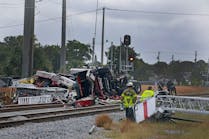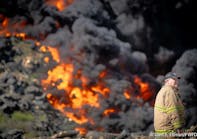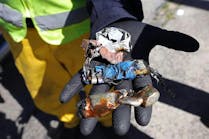The student will demonstrate a basic understanding of ground ladder operations, positioning fire streams with ladders, carrying ground ladders, raising ground ladders, and climbing ground ladders.
Session Reference: 2
Topic: Basic Firefighting: Ground Ladders
Level of Instruction:
Time Required: 3 Hours
Materials:
• Various Ground Ladders
References:
• Truck Company Fireground Operations, Second Edition, Chapters 9
• Essentials of Fire Fighting, Fourth Edition, IFSTA, Chapter
Preparation
Motivation:
Objective (SPO): The student will demonstrate a basic understanding of ground ladder operations, positioning fire streams with ladders, carrying ground ladders, raising ground ladders, and climbing ground ladders.
Overview: Basic Firefighting: Ground Ladders
• Ground ladder operations
• Placement of ladders and climbing techniques
• Positioning fire fighting steams
• Ground ladder practical
Basic Firefighting: Ground Ladders
SPO 2-1 The student will demonstrate a basic understanding of ground ladder operations, positioning fire streams with ladders, carrying ground ladders, raising ground ladders, and climbing ground ladders.
EO 2-1 Identify the purpose of fire service ladders.
EO 2-2 Demonstrate the proper placement of ladders and a safe climbing technique as it pertains to advancing hoselines.
EO 2-3 Describe the techniques of using ground ladders to support fire streams.
EO 2-4 Raise all portable ladders carried on the apparatus using the flat or beam raise, and climb correctly the full length of those ladders (NFPA 1001 (1997) 3-3.5).
Instructional Guide
I. Ground Ladder Operations (2-1)
Introduction
• Within height and personnel limitations, ground ladders can be effective in number of operations
--------------------
• Some uses same as aerial units, but others unique
• Gaining access to fire building and exposed buildings
• Advancing hoselines when stairways are used by people escaping
• Replacing damaged stairways
• Removing trapped victims
• Removing people from crowded fire escapes
• Getting from one roof level to another
• Reinforcing weakened building features
--------------------
• Ladder Work
• Ladder work should be assigned to those performing truck duties
• If laddering duties not specifically assigned, rescue or fire attack operations can be delayed
• Ladder operations affect the efficiency of most other fireground operations
--------------------
• Handling Ground Ladders
• Several ways to carry ground ladders from apparatus
• Method used should require least maneuvering and time
• There should be no need to lay ladder on ground after carrying to building and before raising it
• One way to avoid extra movement is to carry it with rungs and trusses parallel to ground - once butt in position near wall, lower to ground while upper part of ladder raised from shoulder height
• Ladder can then be pivoted and extended if necessary
• Two- and three-person ladders can be quickly placed for beam raise
• Two-person ladder is carried with fire fighters on opposite corners
• Three-person ladder carried with two fire fighters at each end of one truss and one in the middle on other truss
• Four person ladders carried by two fire fighters at each end and additional crew members at or near middle
• If manufacturer makes no recommendation, position fly section away from building
• Climbing angle is determined by height of raise and distance from butt to building - butt to building distance one-quarter of height of raise
--------------------
• Safety
• Be careful of overhead obstructions, especially electric wires
• Once ladder raised, should be tied in to building or braced by fire fighter
• Ladder should not be overloaded - fire fighters should be at least ten feet apart at normal climbing angle
• If climbing angle decreased or hose being carried up, distance between those on ladder should be increased to twenty feet
• Once ladder used to enter building, it should be left in place as exit
II. Advancing Hoselines (2-2)
Placing Ladders
• Should be placed where they will be of use in overall operation
• Size up will indicate where building may have to be entered
• Occasionally, properly positioned ladders will not be needed, possibly because fire was quickly controlled from other positions
• Avoid placing ladders in front of building entrance
--------------------
Climbing Ladders
• Fire fighters carrying lines should be at least fifteen feet apart
• Hose should be grasped at couplings with loops hanging off side of ladder
• Once line advanced into building, it should be moved clear of ladder so it hangs down face of building
III. Positioning Fire Fighting Streams (2-3)
Ladders can be used to hold and position streams being directed into building
• Topmost three or four rungs extend over sill and into window, line is tied to ladder so stream is directed through window opening
• Ladder is raised over window with top placed against wall above, line is tied to ladder, and stream directed onto fire
--------------------
Ladder should be tied to building if possible
• Ladder in windows tied in with rope hose tool
• Ladder against wall tied to pike pole placed across inside of lower window
--------------------
Hoseline should be tied to ladder in manner that will allow rope to absorb some of reaction of line when nozzle opened
• Not tied rigidly to ladder rungs
• Suspended between rungs
--------------------
Can be used to knock down fire ahead of crews advancing interior lines
--------------------
Ladders streams should be shut down as interior lines approach
--------------------
• Once ladder stream has knocked down fire, it can be shut down, untied, advanced, recharged, and used for interior attack
• Allow smoke or steam to clear area
• Check interior conditions
• Enter window only when second fire fighter has climbed to position immediately outside window to assist in advancing line and back up
IV. Ground Ladder Practical (2-4)
Demonstrate the following using ground ladders:
• One, two, and three person beam carries
• Two, three, and four flat person carries
• One, two, three, and four person raises
• Placement for fire fighting, rescue, and roof operations
• Climbing
Review:
Basic Firefighting: Ground Ladders
• Ground ladder operations
• Placement of ladders and climbing techniques
• Positioning fire fighting steams
• Ground ladder practical






